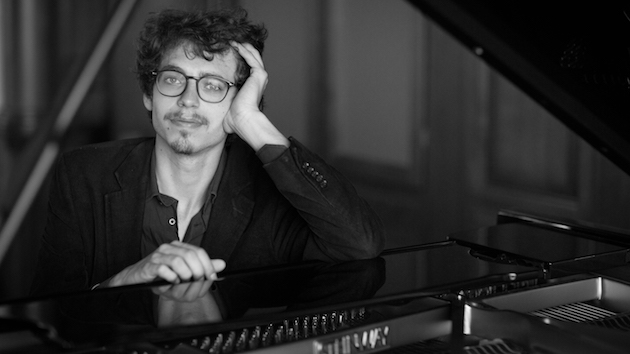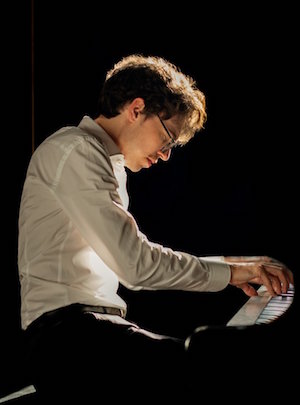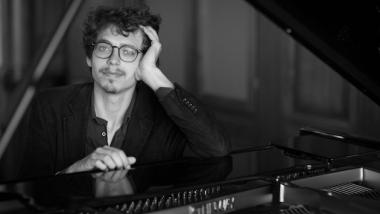
It has been nearly two years since French pianist Lucas Debargue’s sensational performances at the 15th International Tchaikovsky Competition in 2015 shocked the world. Yet the fervor for this unorthodox artist has hardly subsided, and he still garners a deep, passionate interest from piano-music lovers. Electrically charged anticipation filled the sold-out Hertz Hall on Feb 12.
Debargue was dismissed as an oddball at the beginning of the competition, from his sartorial choices to his unconventional training. His unusual approach to music also inflamed doubters. He cemented his position as a credible competitor after his passionate performance of the rarely heard yet extremely ambitious Sonata, Op.5, by Nikolai Medtner, and a ferocious, demonic reading of Ravel’s Gaspard de la Nuit (Gaspar of the Night), a piece inspired by the gothic narrative poem of the same name by Aloysius Bertrand. His San Francisco recital program centered on these works, and the question was whether the riotous fever would be recreated.
Debargue did not disappoint. From the haunting yet seductive reading of Gaspard’s first movement, “Ondine,” which begins with the most delicate shimmering ripples of the lake, Debargue commanded utmost attention to every sigh and torment in the score. Ondine’s call whistled both naively and seductively at the same time, floating above the misty lake scene. The climax depicted Ondine as demented or even perhaps psychotic. Ondine’s tears over her rejected marriage proposal were illustrated with terrifying stillness, adding much drama to Ondine’s disappearance into the water.
In “Le Gibet” (The Gallows), Debargue’s quiet yet horrifying illustration of a bloody corpse hanging in the air, illuminated by the setting sun, against an oppressively persistent ringing of a bell in distance, was accentuated by explosive outbursts. It was singularly the most violent depiction of an execution I’ve ever heard.

Ravel apparently claimed that he wanted to make “Scarbo”, Gaspard’s third movement, a caricature of romanticism, and that it got the better of him. Far more than the irritation implied in Bertrand’s poem, Debargue transported the audience to an entirely different dimension. The poltergeist was far more destructive and sinister, painting the surroundings with screams of terror. The music was extremely fast-paced, yet all the details and articulations were maintained, thanks to the pianist’s abundant technique, which has improved tremendously since the Tchaikovsky competition, and by supplying periods of silence that functioned as demarcations. The two brutal climaxes were delivered with utmost aggression, yet the pounding seemed fitting and appropriate, however shocking it was.
Debargue’s overwhelming and perhaps overbearing interpretation could be criticized for being too extreme in tempo and dynamic range. Here was a performance that unequivocally shattered the previously understood notions of the work’s interpretive boundaries. It was utterly shocking in its savagery, but Debargue successfully lifted the 19th-century poetry into today’s world.
In stark contrast to the visceral Gaspard, Debargue played an intelligently delineated interpretation of the cerebral and ambitious Medtner Sonata. The desperate melody in the first movement was clearly presented, even when it was integrated as a counterpoint to the second theme. Certainly, there were moments when Debargue could not resist the temptation to bring on torrential outbursts, but the movement’s excruciating sorrows remained the focus.
Toward the end of the work, when the first theme returns triumphantly in a major key the intricate architectural beauty of the work evoked Beethoven. With his insight into Medtner’s complexity and the technical facility to support it, Debargue is poised to become an important interpreter of this composer’s work.
The pianist preceded these two works with a somewhat eccentric interpretation of Chopin’s Ballade No. 4. Throughout much of the work, the reading was restrained, with generous support from the left hand and each of the elements clearly balanced. Oft-neglected counterpoints came alive, and he treated each note preciously. Yet, the climax came and went like lightning, with an extremely fast assault of chords. The coda had a violent character, rendering the piece bipolar at the extremes and short in the middle.
The Domenico Scarlatti sonatas included on the program were given anachronistic readings. He opened with the Sonata in C Major, K.132, which mixed a disciplined Baroque style, clear voicing, and meticulous attention to details with a nearly impressionistic presentation of the second theme. It was an interesting contrast, but the time slip was jarring.
Despite the questionable details, Debargue made an utterly convincing case for taking the music beyond the accepted norm, questioning the status quo with a fresh perspective. Not unlike Glenn Gould in the depth and thoroughness of his understanding of music down to the most minute of details, he is “so valid and serious an artist that I must take seriously anything he conceives in good faith,” as Leonard Bernstein said of Gould.

